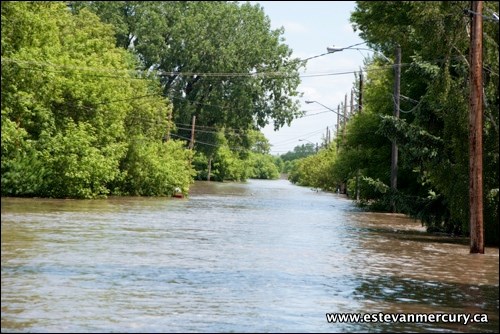It has perhaps always been a perennial problem in Saskatchewan, but for past several years, it is excess water that has been a greater concern than the dry alternative.
Wetlands have been reduced province-wide in an effort to turn as much land into producing acres as possible, and of the few sloughs that remain, they’re fully charged. There doesn’t seem to be as much wiggle room as there once was if a heavy rainfall or period of elevated moisture washes across a region. Around Estevan, it was seen in 2011 and pools or water and a saturated water table have remained ever since. This past spring and summer more flooding was experienced in the Carnduff, Gainsborough and Moosomin areas.
When it comes to water and flooding, these events are never localized. Everything goes down stream and southeast Saskatchewan’s waterways are part of the larger Assiniboine Basin, which includes the Souris River, Qu’Appelle River and Assiniboine River, along with the three separate jurisdictions those systems flow through, Saskatchewan, North Dakota and Manitoba.
As was seen in 2011 when 30,000 people were evacuated from homes in Minot, N.D., what started as a flood event in the Estevan area quickly made its way downstream, destroying other communities like Roche Percee in the process.
From water issues around the Prairies in 2014, there are estimates that the loss to crops alone may amount to more than $1 billion for the agriculture industries in Saskatchewan and Manitoba.
Following years where not enough water was the problem on the Prairies, excess water has fast become the more serious concern in this part of the province.
With the goal of co-ordinating a holistic plan that transcends jurisdiction, the Assiniboine River Basin Initiative was struck about a year ago. Discussions and consultations have been regularly occurring ever since between the plethora of stakeholders from Saskatchewan, Manitoba and North Dakota. Most recently, a three-day conference was held in Regina from Nov. 12 to 14.
The initiative aims to look not just at how to handle and prevent flooding but also how to plan for years of drought. As has been seen in the southeast, the environment can change quickly over just a few years.
Heading the initiative as project manager is Wanda McFayden, who said the ARBI is still in its early stages, but they are hoping to begin projects in the coming spring.
They have been asked by the Manitoba minister of conservation and water if they would be interested in doing a white paper on drainage within the basin, which would focus on what the regulations are across all jurisdictions, what are the gaps and how can the different governments work collaboratively to set policy while recognizing jurisdictional differences.
That may involve some information gathering and sharing so policymakers may see how different situations are handled across the two provinces and one state.
Manitoba’s funding will go toward work that can happen anywhere in the basin and is not strictly meant for projects only covered within Manitoba’s provincial borders.
“They’re saying this is for the betterment of everyone in the basin. It’s a melting pot, because if it’s a project that is positive in the upper reaches of the Qu’Appelle or the Souris, the end point is the Assiniboine at the forks in Winnipeg,” said McFayden.
“If we get a win in Lumsden or in Estevan or Weyburn, then it’s a positive win for Manitoba.”
She said the conference in Regina was a great way for people to come together and realize the scope of their common issues and discussing not just the issues but also how they are currently being handled.
“At this point of time, what the organization is hoping to do is become an advocate for the citizens who live and work in the basin. We realize there are a number of jurisdictional agencies in place such as the International Joint Souris Commission. How can we complement the work that they’re doing and perhaps fill in some of the gaps, and there are some pieces of work that we can do that because they are jurisdictional they cannot do,” said McFayden.
In March the group was asked to develop an organizational structure and sustainable funding model, and that was covered at the conference. While that was laid out for the attendees, there were also break out sessions where smaller groups could examine some of the finer details, like what the board should look like and what some of the early projects may be.
“Now the work begins on all the stuff that we need to do to be incorporated as well as really honing in on those first projects that we can undertake,” noted McFayden.
“We’re all downstream from someone, and we know that when the water goes by us, it’s gathering momentum and it’s going to hit someone else, so how are we going to work collaboratively on this very important issue?”
Those are the questions McFayden hopes will be solved as the projects move forward and the varying jurisdictions get used to working in harmony.



